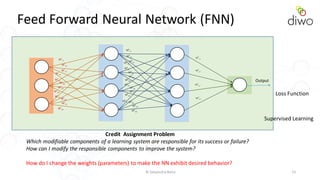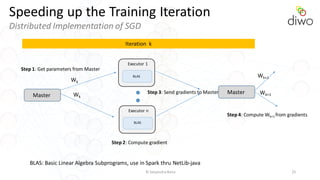Deep learning on spark
- 1. 1
- 2. Learning is about acquiring the ability to discriminate. Memorization Overfitting Under fitting Generalization © Satyendra Rana 2 2 2 4 2 3 5 2 4 6 2 5 7 2 3 ? 2 7 ? 3 4 ? 2 2 4.05 2 3 4.98 4 2 5.95 2 5 7.06 2 3 ? 2 7 ? 3 4 ? Noise
- 3. Machine Learning Data In Wisdom Out © Satyendra Rana 3 ? Square Boxes Thin Rectangular Boxes Round Boxes Q1: Which type of box should we look for? Q2: Having picked up the box type, how do we find the right box? Computational Architecture Learning Method
- 4. Deep (Machine) Learning Data In Wisdom Out © Satyendra Rana 4 ? Type of box? Right box? Computational Architecture Learning Method Discrimination Ability? Finer Discrimination (Non-linearity) Network of Neurons (aka Neural Network or NN)
- 5. © Satyendra Rana 5 Natural Language Generation
- 6. © Satyendra Rana 6 Machine Translation
- 7. © Satyendra Rana 7 Automatic Image Captioning
- 8. © Satyendra Rana 8 Automatic Colorization of Gray Scale Images Input Image Automatically Colorized Ground-Truth Source: Nvidia news
- 9. © Satyendra Rana 9 Ping Pong Playing Robot Source: Omron Automation Lab Kyoto, Japan
- 10. © Satyendra Rana 10 Deep learning for the sight-impaired (and also for the sight-endowed)
- 11. © Satyendra Rana 11 Neurons Adult Brain - 100 Trillion Infant Brain – 1 Quadrillion Synapses
- 12. © Satyendra Rana 12 Model of a Neuron & Artificial Neural Networks I N P U T w0 w1 w2 w3 w4 Hyper-parameters - number of layers - type & number of neurons in each layer Parameters - weights (one for each connection)
- 13. © Satyendra Rana 13 Multi-layered Neural Network Synapse Scale Typical NNs - 1-10 Million Google Brain – 1 Billion More Recent Ones – 10 Billion Given a fixed number of neurons, spreading them in more layers (deep structure) is more effective than in fewer layers (shallow structure). Given a fixed number of layers, higher number of neurons is better than fewer. Deep Neural Networks are powerful, but they must also be trainable to be useful. Different kinds of Deep Neural Networks Feed Forward NNs Recurrent NNs Recursive NNs Convolutional NNs
- 14. © Satyendra Rana 14 How does a Neural Network Learn? Parameters Learning problem is to find the best combination of parameter values, among all possible choices, which would give us on an average most accurate (or minimum error) result (output) in all possible situations (inputs).
- 15. © Satyendra Rana 15 Feed Forward Neural Network (FNN) W1 11 W1 12 W1 13 W1 14 W1 21 W1 22 W1 23 W1 24 W1 31 W1 32 W1 33 W1 34 W2 11 W2 12 W2 13W2 14 W2 21 W2 22 W2 23 W2 24 W2 31 W2 32 W2 33 W2 34 W2 41 W2 42 W2 43 W2 44 W3 21 W3 11 W3 31 W3 41 Loss Function Output Credit Assignment Problem Which modifiable components of a learning system are responsible for its success or failure? How can I modify the responsible components to improve the system? How do I change the weights (parameters) to make the NN exhibit desired behavior? Supervised Learning
- 16. © Satyendra Rana 16 Passing the Buck Example: Fine Tuning a Sales Team Performance W1 11 W1 12 W1 13 W1 14 W1 21 W1 22 W1 23 W1 24 W1 31 W1 32 W1 33 W1 34 W2 11 W2 12 W2 13W2 14 W2 21 W2 22 W2 23 W2 24 W2 31 W2 32 W2 33 W2 34 W2 41 W2 42 W2 43 W2 44 W3 21 W3 11 W3 31 W3 41 Loss Function Output Backward Propagation Propagating the error backwards from layer to layer, so that each layer can tweak its weights to account for their share of responsibility. (direction, amount)
- 17. © Satyendra Rana 17 Fn-2(Xn-3, Wn-2) Fn-1(Xn-2, Wn-1) Fn(Xn-1, Wn)Wn Wn-2 Wn-1 Xn-1 Xn-2 Xn-3 X1 Xn C (Xn, Y) Y E Directionn Directionn-1 Directionn-2 ForwardPass BackwardPass Directionn = DF( Xn, C(Xn, Y)) Directionn-1 = Directionn *DF( Xn-1, Fn(Xn-1, Wn)) Directionn-2 = Directionn-1 *DF( Xn-1, Fn(Xn-2, Wn-1)) Directionn-3 = Directionn-2 *DF( Xn-2, Fn(Xn-3, Wn-2)) Stochastic Gradient Descent (SGD)
- 18. © Satyendra Rana 18 Base camp You are here Climbing down Mountains with Zero Gravity Steepest Descent Learning rate Epoch
- 19. © Satyendra Rana 19 What changed since the 80’s? 1970 1975 1980 1985 1990 2010 2015 2020 Early NN Activity Deep NN Activity • Slow Computers • Small Data Sets • Faster Computers • Big Data • Training Issues Big Data & Deep Learning Symbiosis
- 20. © Satyendra Rana 20 Reaching Saturation Point in Learning I don’t want to learn anymore.
- 21. © Satyendra Rana 21 Vanishing (or Unstable) Gradient Problem (Gradient at a layer involves the multiplication of gradient at previous layers) What is the fix? 1. Random Initialization of Weights 2. Pre-Training of Layers 3. Choice of activation function • Rectified Linear Unit (RELU) 4. Don’t use SGD 5. LSTM
- 22. © Satyendra Rana 22 Implementation of Deep Learning It’s all about scaling 1. Implementing a Neuron 2. Implementing a Layer 3. Composing Layers (Building the network) 4. Implementing a Training (Learning) Iteration, aka epoch 5. Learning Hyper-parameters
- 23. © Satyendra Rana 23 Implementation of Neuron / Layer Neuron Abstraction Layer Abstraction Fast Matrix / Tensor Computation Libraries • Exploitingmulti-threaded multi-core architectures • GPU Acceleration Single Node Architecture Shared Memory Shared Memory Memory GPU Memory GPU Single Node Architecture GPU Accelerated Activation Functions Loss Functions Node 1 Node 2 Node 3
- 24. © Satyendra Rana 24 Composing Layers / Building a Neural Network 1. Specifying Layer Composition (network specification) SparkML val mlp = new MultilayerPerceptronClassifier() .setLayers(Array(784, 300, 100, 10)) .setBlockSize(128) SparkNet val netparams = NetParams( RDDLayer(“data”, shape=List(batchsize, 1, 28, 28)), RDDLayer(“label”, shape=List(batchsize, 1)), ConvLayer(“conv1”, List(“data”), Kernel=(5,5), numFilters=20), PoolLayer(“pool1”, List(“conv1”), pool=Max, kernel=(2,2), stride=(2,2)), ConvLayer(“conv2”, List(“pool1”), Kernel=(5,5), numFilters=50), PoolLayer(“pool2”, List(“conv2”), pool=Max, kernel=(2,2), stride=(2,2)), LinearLayer(“ip1”, List(“pool2”), numOutputs=500), ActivationLayer(“relu1”, List(“ip1”), activation=ReLU), LinearLayer(“ip2”, List(“relu1”), numOutputs=10), SoftmaxWithLoss(“loss”, List(“ip2”, “label”)) ) 2. Allocating layers to nodes
- 25. © Satyendra Rana 25 Speeding up the Training Iteration Distributed Implementation of SGD Executor 1 BLAS Master Executor n BLAS Wk Wk Step 1: Get parameters from Master Step 2: Compute gradient Step 3: Send gradients to Master Master Step 4: Compute Wk+1 from gradients Wk+1 Wk+1 Iteration k BLAS: Basic Linear Algebra Subprograms, use in Spark thru NetLib-java
- 26. © Satyendra Rana 26 MultilayerPerceptronClassifier() in Spark ML Scala Code val digits: DataFrame = sqlContext.read.format(“libsvm”).load(“/data/mnist”) val mlp = new MultilayerPerceptronClassifier() .setLayers(Array(784, 300, 100, 10)) .setBlockSize(128) val model=mlp.fit(digits) Features (input) Classes (output) Hidden layer With 300 neurons Hidden layer With 100 neurons
- 27. © Satyendra Rana 27 SparkNet: Training Deep Networks in Spark Executor 3 GPU Caffe Executor 2 GPU Caffe Executor 1 GPU Caffe Executor 4 GPU Caffe Master Data Shard 1 Data Shard 2 Data Shard 3 Data Shard 4 2. Run SGD on a mini-batch for a fixed time/iterations 3. Send parameters to master 1. Broadcast model parameters 4. Receive parameters from executors 5. Average them to get new parameters 2. Run SGD on a mini-batch for a fixed time/iterations 3. Send parameters to master 2. Run SGD on a mini-batch for a fixed time/iterations 3. Send parameters to master 2. Run SGD on a mini-batch for a fixed time/iterations 3. Send parameters to master
- 28. © Satyendra Rana 28 with Best Model Model # 1 Training Model # 2 Training Model # 3 Training Distributed Cross Validation
- 29. © Satyendra Rana 29 Apache SINGA A General Distributed Deep Learning Platform
- 30. Why “Deep Learning” on Spark? Sorry, I don’t have a GPU / GPU Cluster A 3-to-5 node Spark cluster can be as fast as a GPU Most of my application and data resides on a Spark Cluster Integrating Model Training with existing data-processing pipelines High-throughput loading and pre-processing of data and the ability to keep data in between operations. Hyper-parameter learning Poor man’s deep learning It’s simply fun … © Satyendra Rana 30





























